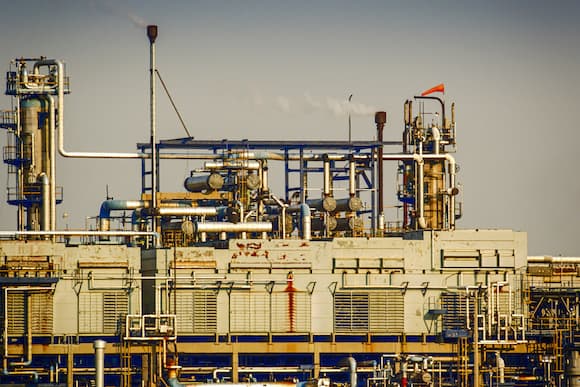
An oil refinery in Detroit
Automobiles. Agriculture. Tourism. These are probably the words that come to mind when people think of industries that contribute most to Michigan’s economy. But what about oil and natural gas? A recent economic impact study published by Public Sector Consultants (PSC) shows that activities related to oil and natural gas create tens of thousands of jobs and billions of dollars of income for the state’s residents.
“Michigan isn’t a big oil and gas state like Texas or Alaska,” says Jeff Cook, board chair of the Michigan Oil and Gas Association (MOGA), the organization for whom PSC prepared the report. “But our energy reserves are significant, our proven environmental regulations are a national model and our future looks as stable and steady as our past.”
What exactly does the past look like? In 2015, the state’s oil and gas industry drove $13.6 billion in economic output, generated about $419 million in state and local taxes and directly and indirectly supported more than 47,000 jobs.
It also has significant growth potential. Between 2005 and 2014, employment in the industry doubled. Jobs are expected to increase an additional 46 percent over the next ten years, making it a Michigan industry to watch.
One of the things PSC vice president and report author Jeff Guilfoyle likes most about the study, though, is that it doesn’t stop at providing statewide information.
“We also show — county by county — how much oil or gas is being produced, how much income is being generated and how many jobs are supported,” he says.
“Our oil and gas industry in Michigan is made up mostly of small, local, family companies that have not only helped us meet our energy needs, but have been putting dinner on people’s tables for generations.”
The report’s county-specific data reveals some pretty interesting facts. For example, most people probably don’t know that oil is being taken out of the ground in Oakland County or that, in 2014, Jackson County produced the most oil and Otsego County produced the most natural gas. They probably also don’t know how many of the state’s counties are touched by the industry.
“We found that 62 of Michigan’s 83 counties [75 percent] produced oil and/or natural gas in 2014, and 82 of our 83 counties [99 percent] experienced some economic activity as a result of the oil and gas industry,” Guilfoyle explains.
That makes it an unequivocal statewide economic force, not just a local or regional contributor as some may have previously thought.
The study also elucidates the important role the oil and natural gas industry plays in Michiganders’ quality of life — a role that is not at all well known or understood.
“Look around your community’s green spaces,” says Cook. “You’ll find evidence of more than a billion dollars of oil and natural gas revenue enhancing every county of the state.”
That revenue comes mostly from royalties paid on the oil and natural gas that is extracted from state-owned lands. The royalties go into two funds: the Michigan Natural Resources Trust Fund (MNRTF) and the Michigan State Parks Endowment Fund (MSPEF).
Since its inception, MNRTF dollars — which are used to purchase land for resource protection and conservation as well as to fund outdoor recreation projects — have enabled Michigan to acquire more than 1,200 local and state properties and fund more than 970 local and state development projects.
“It’s quite possible that the trailhead in your community, or the fishing pier, or the baseball field or that new recreational building’s bathroom was built with funds from the MNRTF,” says Guilfoyle.
In a state where the number of people aged 44 and younger has declined significantly over the last 10 years, these placemaking efforts are particularly important. They attract young families to Michigan communities and give them a reason to stay.
The MSPEF, by contrast, uses revenues from the oil and natural gas industry to support the operations of state parks. In 2014, the industry generated more than $153 million in revenues, or about one-third of what it takes annually to operate Michigan’s state park system — a system that not too long ago won the National Recreation and Park Association’s gold medal award for the top state park system in the nation.
Royalties, bonuses and lease payments for oil and natural gas found on private lands have significant economic value, too.
“There are lots of people in Michigan who aren’t full-time oil and gas folks, but they have a well on their property that generates royalties, which is an important source of income for them,” Guilfoyle explains.
The PSC study shows that, in 2014, the industry paid about $214.5 million in royalties to private individuals. Of that amount, more than $124.4 million came from oil and $90.1 million came from natural gas. Another $37.8 million was paid out in lease and bonus payments.
“Our oil and gas industry in Michigan is made up mostly of small, local, family companies that have not only helped us meet our energy needs, but have been putting dinner on people’s tables for generations,” says Cook.
To prepare its study for MOGA, PSC used the IMPLAN model, which allows economic impact estimates to be made at the state, county and even zip-code level. The firm has used it for several studies so far and hopes to continue using it to help other industries better understand their economic impact and potential.
“I love using this model to do our work,” says Guilfoyle. “It’s not only accurate and effective, but it also enables us to generate data at a level that people can actually use and connect with.”


